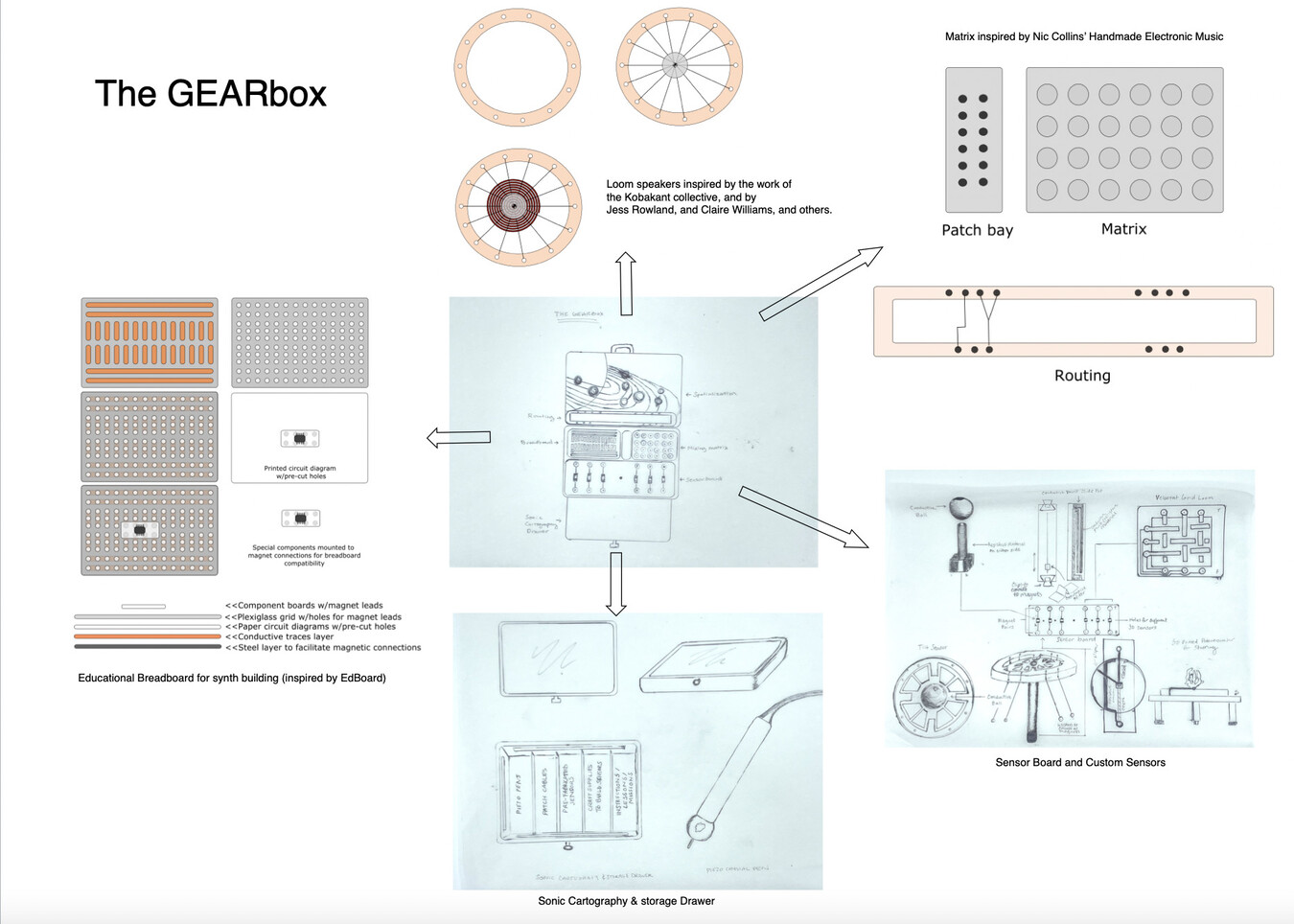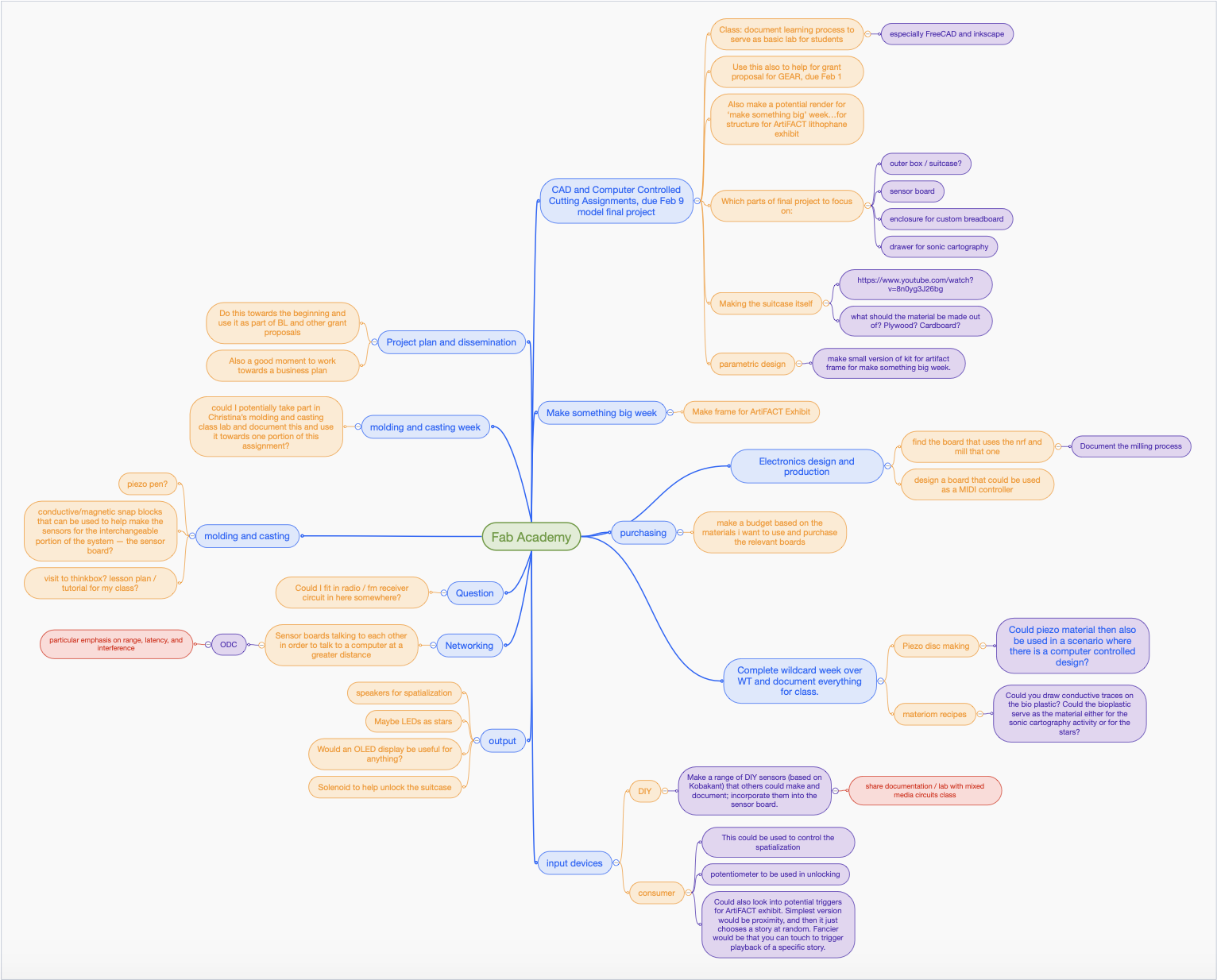1. Principles and practices¶
Our Homework this week¶
This week’s assignment is to:
- Plan and sketch a potential final project
Learning outcomes include:¶
- communicate an initial project proposal
Have you answered these questions?¶
- Sketched your final project idea/s
- Described briefly what it will do and who will use it
My Final Project Proposal¶

The GEAR[box] is a modular music-making STEAM education toolkit that fits in a suitcase. It is named after the Girls Electronic Arts Retreat, a STEAM summer camp I launched in 2019. The ‘box’ part of the name is intended to invoke the idea of a boombox. (I also stole the brackets in the name from Think[box], a gigantic makerspace about an hour from where I live.) Inside the box there are several different tools to generate and/or manipulate sound: a sensor board, a custom breadboard, a matrix, patch bays, a modular paper audio mixer, a sonic cartography drawer (more on that later), and a spatialization system. Each of these sections functions independently, but can also be used in combination as a tool for creative musical expression and electronics education.
Here is a slightly updated sketch here:

What will it do and who will use it?¶
The GEAR[box] is a modular toolkit that supports authentically integrated STEM and arts learning. It has modules and/or kits dedicated to circuit building, sensing, transduction and electromagnetism, spatialization, mixing, signal routing, graphic notation, and more. The GEAR[box] is designed to support kids ages 8+ and in particular, will be used by kids in the Girls Electronic Arts Retreat to compose, improvise, and perform music, perhaps to facilitate virtual ‘travel’ through digital space, and to learn about electronics, music technology, and creative sonic practice.
You can also think of my project like the TIMARA (Technology in Music Related Arts) studios in a box. The different modules in the box are loosely based on the different resources we have in TIMARA. While we regularly bring kids to our studios, we also try to get out to different schools when possible. Often this involves a ton of packing and unpacking of equipment and supplies, and there are many technologies that just don’t travel well. I’m excited about the idea of having boxes always ready to go that will support STEAM education activities outside of the studios.
Prior Research¶
The GEAR[box] is inspired by a whole slew of projects by others and also by prior research I have been working on with my students in the Crafting Sound Lab. I will share photos of my lab’s prior research in the final project page and also go into more detail about other project inspirations on that page, but here are a few relevant links for starters:
- Travis Johns Suitcase Synth
- EdBoard
- Little Bits
- Chibitronics
- Nic Collins’ Handmade Electronic Music
- Kobakant Collective
- Claire Williams
- Jess Rowland
- Machine in a suitcase (I have seen Neil show this project several times but am having trouble tracking it down right now.)
Questions¶
At the start of this journey I have quite a lot of questions that I hope to sort out in the coming months:
- Will the GEAR[box] be too expensive to be useful? I want to build a tool that I can afford to deploy in a camp, but I’m worried that the cost of the materials and the time required for fabrication will make the project too expensive.
- I am very torn about the output for the sensor board and would value advice about how to proceed.
- Originally, I wanted to send ASCII or MIDI data to a computer from the sensor board in order to be able to interface with Scratch or another kid-friendly programming language. I was imagining that the sensor board could almost function like navigation instruments for kids to move around a virtual space that they created. I wanted to find a middle ground between a Makey-Makey and an Arduino in order to allow kids to more easily create expressive STEAM projects that with both digital and physical components. I am very excited about the potential range of learning activities that this approach would support.
- More recently, I have been thinking that I should focus the suitcase entirely on music and sound generation. In this case, the output of the sensor board would be sound that could be routed with a patch cord to another module in the box. The main benefit to this approach is that it is probably a bit simpler and it keeps the project entirely in the realm of creative sonic expression.
Planning¶
As I have been working on my initial sketches and project development plan, I am keenly aware of the time demands of Fab Academy and also of my day job and the different projects I am juggling. Luckily, there is some overlap between the structure of Fab Academy and several of my other projects and responsibilities this semester. In order to make the most out of my time in Fab Academy, therefore, I have been trying to map out this overlap, to make a semester plan, and to sketch out how I will use the different assignments towards my final project (or towards other concurrent projects) as much as possible.
Here is a quick mind map I made to start thinking about connections between my other responsibilities and Fab Academy:

Before Fab Academy I had never heard of a Gantt chart. I have started to map out my semester and also my project using the Gantt Project open source software. Since I am trying to tie my final class project to my existing responsibilities, I am sharing a semester overview image here. It is more like a calendar than a project plan at the moment. I’m definitely still getting the hang of the software and the planning process, but I can see how this will be a really useful tool and will continue to revisit it over the course of the class. I’m working on a project plan and will update it here or on my final project page when it is ready.

